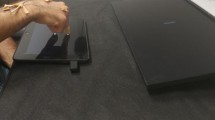Abstract
Visually guided grasping movements directed to real, 3D objects are characterized by a distinguishable trajectory pattern that evades the influence of Weber’s law, a basic principle of perception. Conversely, grasping trajectories directed to 2D line drawings of objects adhere to Weber’s law. It can be argued, therefore, that during 2D grasping, the visuomotor system fails at operating in analytic mode and is intruded by irrelevant perceptual information. Here, we explored the visual and tactile cues that enable such analytic processing during grasping. In Experiment 1, we compared grasping directed to 3D objects with grasping directed to 2D object photos. Grasping directed to photos adhered to Weber’s law, suggesting that richness in visual detail does not contribute to analytic processing. In Experiment 2, we tested whether the visual presentation of 3D objects could support analytic processing even when only partial object-specific tactile information is provided. Surprisingly, grasping could be performed in an analytic fashion, violating Weber’s law. In Experiment 3, participants were denied of any haptic feedback at the end of the movement and grasping trajectories again showed adherence to Weber’s law. Taken together, the findings suggest that the presentation of real objects combined with indirect haptic information at the end of the movement is sufficient to allow analytic processing during grasp.








Similar content being viewed by others
References
Bingham, G., Coats, R., & Mon-Williams, M. (2007). Natural prehension in trials without haptic feedback but only when calibration is allowed. Neuropsychologia, 45(2), 288–294.
Bruno, N., Uccelli, S., Viviani, E., & de’Sperati, C. (2016). Both vision-for-perception and vision-for-action follow Weber’s law at small object sizes, but violate it at larger sizes. Neuropsychologia, 91, 327–334.
Christiansen, J. H., Christensen, J., Grünbaum, T., & Kyllingsbæk, S. (2014). A common representation of spatial features drives action and perception: grasping and judging object features within trials. PloS one, 9(5), e94744.
De-Wit, L. H., Kubilius, J., de Beeck, H. P. O., & Wagemans, J. (2013). Configural gestalts remain nothing more than the sum of their parts in visual agnosia. I-Perception, 4(8), 493–497.
Eloka, O., Feuerhake, F., Janczyk, M., & Franz, V. H. (2015). Garner-interference in left-handed awkward grasping. Psychological Research, 79(4), 579–589.
Freud, E., & Ganel, T. (2015). Visual control of action directed toward two-dimensional objects relies on holistic processing of object shape. Psychonomic Bulletin & Review, 2003, 1377–1382.
Freud, E., Macdonald, S. N., Chen, J., Quinlan, D. J., Goodale, M. A., & Culham, J. C. (2017). Getting a grip on reality: Grasping movements directed to real objects and images rely on dissociable neural representations. Cortex. doi:10.1016/j.cortex.2017.02.020.
Ganel, T. (2015). Weber's law in grasping. Journal of vision , 15(8), 18.
Ganel, T., Chajut, E., & Algom, D. (2008a). Visual coding for action violates fundamental psychophysical principles. Current Biology, 18(14), 599–601.
Ganel, T., Chajut, E., Tanzer, M., & Algom, D. (2008). Response: When does grasping escape Weber's law?. Current Biology, 18(23), R1090–R1091.
Ganel, T., Freud, E., & Meiran, N. (2014). Action is immune to the effects of Weber’s law throughout the entire grasping trajectory. Journal of Vision, 14(7), 1–11.
Ganel, T., Namdar, G., & Mirsky, A. (2017). Bimanual grasping does not adhere to Weber’s law. Scientific Reports. doi:10.1038/s41598-017-06799-4.
Gerhard, T. M., Culham, J. C., & Schwarzer, G. (2016). Distinct visual processing of real objects and pictures of those objects in 7-to 9-month-old infants. Frontiers in Psychology, 7, 827. doi:10.3389/fpsyg.2016.00827.
Gibson, J. J. (1979). The Ecological Approach to the Visual Perception. Boston: Houghton Mifflin.
Gonzalez, C. L. R., Ganel, T., Whitwell, R. L., Morrissey, B., & Goodale, M. A. (2008). Practice makes perfect, but only with the right hand: Sensitivity to perceptual illusions with awkward grasps decreases with practice in the right but not the left hand. Neuropsychologia, 46(2), 624–631.
Goodale, M. A., & Ganel, T. (2015). Different modes of visual organization for perception and for action. Oxford Handbook of Perceptual Organization, 3(1), 1–19.
Goodale, M. A., Jakobson, L. S., & Keillor, J. M. (1994). Differences in the visual control of pantomimed and natural grasping movements. Neuropsychologia, 32(94), 1159–1178.
Goodale, M. A., & Milner, A. D. (1992). Separate visual pathways for perception and action. Trends in Neurosciences, 15(I), 20–25.
Goodale, M. A., & Milner, A. D. (1991). A neurological dissociation between perceiving objects and grasping them. Nature, 349(6305), 154.
Heath, M., Manzone, J., Khan, M., & Jazi, S. D. (2017). Vision for action and perception elicit dissociable adherence to Weber’s law across a range of ‘graspable’ target objects. Experimental Brain Research. doi:10.1007/s00221-017-5025-1.
Hesse, C., Ball, K., & Schenk, T. (2012). Visuomotor performance based on peripheral vision is impaired in the visual form agnostic patient DF. Neuropsychologia, 50(1), 90–97.
Himmelbach, M., Boehme, R., & Karnath, H. O. (2012). 20 years later: A second look on DF’s motor behaviour. Neuropsychologia, 50(1), 139–144.
Holmes, S. A., & Heath, M. (2013). Goal-directed grasping: The dimensional properties of an object influence the nature of the visual information mediating aperture shaping. Brain and Cognition, 82(1), 18–24.
Hosang, S., Chan, J., Jazi, S. D., & Heath, M. (2016). Grasping a 2D object: terminal haptic feedback supports an absolute visuo-haptic calibration. Experimental Brain Research, 234(4), 945–954.
Jakobson, L. S., & Goodale, M. A. (1991). Factors affecting higher-order movement planning: A kinematic analysis of human prehension. Experimental Brain Research, 86(1), 199–208.
Janczyk, M., Franz, V. H., & Kunde, W. (2010). Grasping for parsimony: Do some motor actions escape dorsal processing? Neuropsychologia, 48(12), 3405–3415.
Jarmasz, J., & Hollands, J. G. (2009). Confidence intervals in repeated-measures designs: The number of observations principle. Canadian Journal of Experimental Psychology (Revue canadienne de psychologie expérimentale), 63(2), 124.
Jeannerod, M. (1984). The timing of natural prehension movements. Journal of Motor Behavior, 16(3), 235–254.
Johansson, R. S., & Flanagan, J. R. (2009). Sensory control of object manipulation. Sensorimotor Control of Grasping: Physiology and Pathophysiology, 141–160.
Kwok, R. M., & Braddick, O. J. (2003). When does the Titchener Circles illusion exert an effect on grasping? Two- and three-dimensional targets. Neuropsychologia, 41(8), 932–940.
Löwenkamp, C., Gärtner, W., Haus, I. D., & Franz, V. H. (2015). Semantic grasping escapes Weber’s law. Neuropsychologia, 70, 235–245.
Manzone, J., Jazi, S. D., Whitwell, R. L., & Heath, M. (2017). Biomechanical constraints do not influence pantomime-grasping adherence to Weber’s law: A reply to Utz et al. (2015). Vision Research, 130, 31–35.
Pavese, A., Buxbaum, L. J., & Laurel, J. (2002). Action matters : The role of action plans and object affordances in selection for action. Visual Cognition, 9, 559–590.
Rossit, S., Harvey, M., Butler, S. H., Szymanek, L., Morand, S., Monaco, S., & McIntosh, R. D. (2017). Impaired peripheral reaching and on-line corrections in patient DF: Optic ataxia with visual form agnosia. Cortex. doi:10.1016/j.cortex.2017.04.004.
Schenk, T. (2012). No dissociation between perception and action in patient DF when haptic feedback is withdrawn. Journal of Neuroscience, 32(6), 2013–2017.
Smeets, J. B., & Brenner, E. (2008). Grasping Weber’s law. Current Biology, 18(23), R1089–R1090.
Snow, J. C., Pettypiece, C. E., McAdam, T. D., McLean, A. D., Stroman, P. W., Goodale, M. A., & Culham, J. C. (2011). Bringing the real world into the fMRI scanner: Repetition effects for pictures versus real objects. Scientific Reports, 1, 1–10.
Snow, J. C., Strother, L., & Humphreys, G. W. (2014). Haptic shape processing in visual cortex. Journal of Cognitive Neuroscience, 26(5), 1154–1167.
Tucker, M., & Ellis, R. (1998). On the relations between seen objects and components of potential actions. Journal of Experimental Psychology: Human Perception and Performance, 24(3), 830–846.
Tucker, M., & Ellis, R. (2004). Action priming by briefly presented objects. Acta Psychologica, 116(2), 185–203.
Ungerleider, L. G., & Mishkin, M. (1982). Two cortical visual systems. In D. J. Ingle, M. A. Goodale, & R. J. W. Mansfield (Eds.), Analysis of visual behavior (pp. 549-586). Cambridge: MIT Press.
Utz, K. S., Hesse, C., Aschenneller, N., & Schenk, T. (2015). Biomechanical factors may explain why grasping violates Weber’s law. Vision Research, 111, 22–30.
Westwood, D. A., Danckert, J., Servos, P., & Goodale, M. A. (2002). Grasping two-dimensional images and three-dimensional objects in visual-form agnosia. Experimental Brain Research, 144(2), 262–267.
Whitwell, R. L., Ganel, T., Byrne, C. M., & Goodale, M. A. (2015). Real-time vision, tactile cues, and visual form agnosia: Removing haptic feedback from a “natural” grasping task induces pantomime-like grasps. Frontiers in Human Neuroscience, 9, 216.
Whitwell, R. L., Milner, A. D., Cavina-Pratesi, C., Byrne, C. M., & Goodale, M. A. (2014). DF’s visual brain in action: the role of tactile cues. Neuropsychologia, 55, 41–50.
Wood, D. K., Chouinard, P. A., Major, A. J., & Goodale, M. A. (2016). Sensitivity to biomechanical limitations during postural decision-making depends on the integrity of posterior superior parietal cortex. Cortex. doi:10.1016/j.cortex.2016.07.005.
Acknowledgements
This study was supported by an Israel Science Foundation (ISF) Grant 274/15 to Tzvi Ganel and to Daniel Algom.
Author information
Authors and Affiliations
Corresponding author
Ethics declarations
Conflict of interest
Tzvi Ganel declares that he has no conflict of interest. Aviad Ozana declares that he has no conflict of interest.
Ethical approval
All procedures performed in this study were in accordance with the ethical standards of the Psychology department research committee in BGU and with the 1964 Helsinki declaration and its later amendments or comparable ethical standards.
Rights and permissions
About this article
Cite this article
Ozana, A., Ganel, T. Weber’s law in 2D and 3D grasping. Psychological Research 83, 977–988 (2019). https://doi.org/10.1007/s00426-017-0913-3
Received:
Accepted:
Published:
Issue Date:
DOI: https://doi.org/10.1007/s00426-017-0913-3




